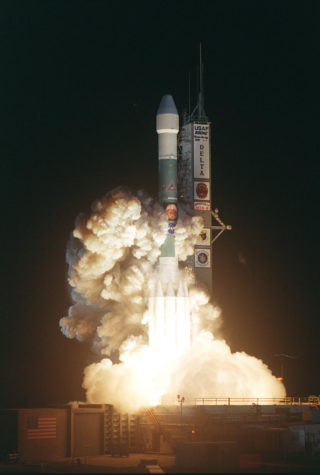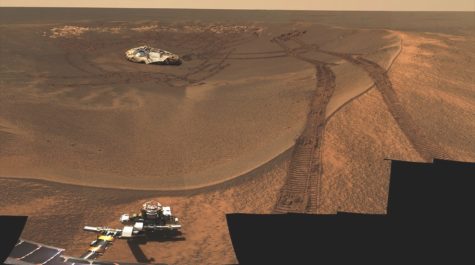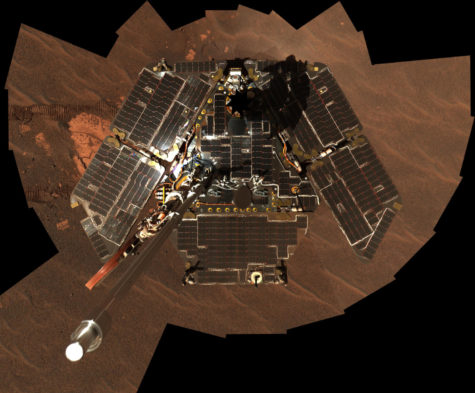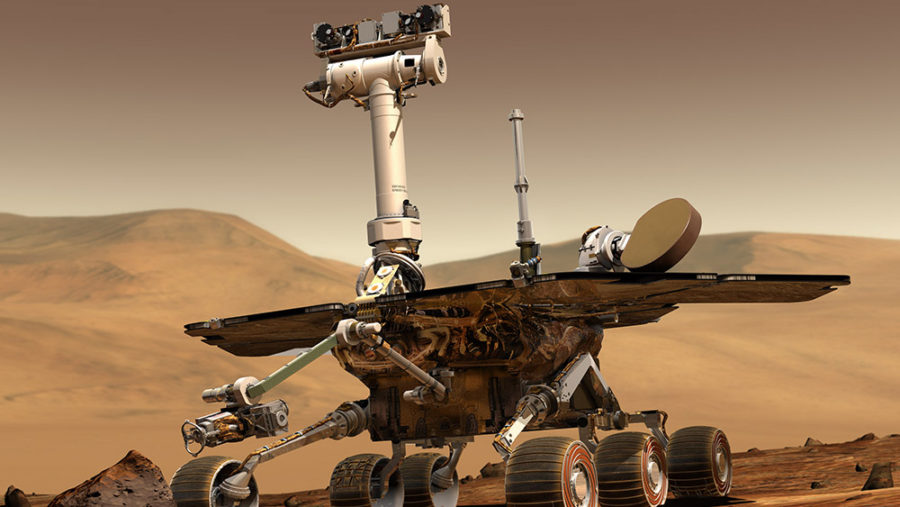After Eight Months of Silence, NASA Says a Final Goodbye to the Opportunity Rover
On Feb. 13, 2019, NASA announced that the Opportunity Rover was dead after more than 14 years of roving around the Martian surface until a historic dust storm in June of 2018 caused NASA to lose communication with the rover. Here’s a look back on the historic mission.
The Mars Exploration Rovers, named Spirit (MER-2) and Opportunity (MER-1) were twin rovers built by NASA’s Jet Propulsion Laboratory (JPL) in Pasadena, California. The mission was chosen after the successful Mars Pathfinder mission in 1997. Pathfinder also had an experimental lander called Sojourner which travelled 100 meters. At the time, JPL followed the philosophy “faster, better, cheaper.” Overall, the Pathfinder mission cost only $150 million dollars. The Mars Exploration Rovers would eventually cost a total of $820 million dollars, which in relation to other NASA projects, this was a low budget compared to the $2.5 billion budget for Curiosity.
In 2000, scientists knew much less than they do now about Mars. At the same time, only the Mars Global Surveyor satellite orbited mars. JPL was still bitter from two mission failures to Mars in the late 1990s. The Mars Polar Lander crashed during its descent to the Martian surface in 1999 due to the decent rockets prematurely shutting down and the lander then plummeted to the ground, impacting at a fast velocity. That same year in September, NASA lost contact with the Mars Climate Observer satellite.

Opportunity’s sister, Spirit, launched on June 10, 2003 from Space Launch Complex-17A at Cape Canaveral Air Force Station. After a launch delay of nine days, at 23:18:15 EDT the Delta II heavy rocket carrying Opportunity finally launched from Space Launch Complex-17B at Cape Canaveral Air Force Station on July 7, 2003.
Spirit landed at Gusev Crater, Mars on Jan. 4, 2004. Once Spirit landed in Gusev Crater, it found some hills which it named the Columbia Hills, to honor the astronauts who perished aboard Space Shuttle Columbia on STS-107. On Jan 21, Spirit encountered a problem in which a software error caused Spirit to continuously reboot its main computer. This error caused NASA to stop receiving data from the rover. Eventually, NASA fixed the problem and science operations returned to normal.
Opportunity ended it’s 6.5-month cruise when on Jan. 25, it entered the Martian atmosphere. After the searing heat of the atmosphere, the aeroshell opened its hypersonic parachute to slow down. Then, the heat shield was jettisoned. Not long after, the rover slid down a bridle, the retro rockets fired, and the airbags deployed. After that, the bridle was cut and the rover bounced the surface of Mars due to the airbags. Once, the rover stopped, the airbags were deflated and the three petals of the landing craft opened revealing Opportunity.
Opportunity landed in a small crater, named Eagle Crater, in the region known as Meridiani Planum. NASA called the landing a “hole in one.” After landing, the landing site was renamed Challenger Memorial Station in honor of the astronauts who died aboard Space Shuttle Challenger on STS-51L.
Unlike Spirit’s landing site at Gusev Crater which turned out to be less favorable to study past signs of water, Meridiani turned out to be a very desirable site.
By Sol 15 (1 Sol is one Martian day, just over 24 hours), Opportunity had driven off of its landing craft and was exploring Eagle Crater. The rock outcroppings in Eagle Crater were of high interest to the rover team. In Eagle Crater, Opportunity dug a small trench using one of it’s wheels to view Martian subsoil. Then Opportunity drilled into some Martian rock on the El Capitan outcropping on Sol 30.

Next, Opportunity drove out of Eagle Crater and started its trek to Endurance Crater. Opportunity reached Endurance Crater on Sol 95. By this time the little rover had outlasted its 90-day warranty by five days. After driving around the crater rim, mission controllers decided to drive Opportunity into Endurance Crater. This decision was a risk because there was a chance it would be too steep to get the little rover out of Endurance Crater at a later time. Overall, Opportunity spent 180 Sols in Endurance Crater.
After climbing out of Endurance Crater, Opportunity started the journey south to Vostok Crater. In December of 2004, Opportunity discovered its heat shield which was jettisoned during descent. Not far from the heat shield, the rover found a small meteorite in the soil, called “heat shield rock.”
On the way, Opportunity set a single day record of driving 772ft. On April 26, 2005, Opportunity got stuck in a 12-inch high dune. After spending a total of 38 Sols stuck, the rover was finally freed and the dune was named “Purgatory Dune.” A new target was also selected, Erebus Crater. In order to prevent another issue in sand dunes, mission controllers at JPL sent Opportunity new software. The new software proved itself useful when on Sol 603, a slippage caused the rover to stop moving.
By Sol 628, Opportunity had to hunker down for a three-day dust storm. Since the Mars Exploration Rovers are Solar Powered, dust storms can endanger the rover. Not long after, a cleaning event occurred.
Meanwhile in Gusev Crater, Opportunity’s twin Spirit experienced a cleaning event on its solar panels which increased its power. Spirit climbed Husband Hill, located in the group of hills called the Columbia Hills. This was the first time a rover had climbed a hill on a planet other than Earth.
On Sept 26, 2006, Opportunity reached a 7-km of around 4-mile-wide crater called Victoria Crater. There, the rover experienced a large cleaning event. In June of 2007, a dust storm swept over both rovers, but they emerged unscathed.
After departing Victoria Crater around Sol 1634, Opportunity began the planned two-year journey to Endeavour Crater. In July of 2009, Opportunity made a slight detour in order to view what turned out to be a series of meteorites laying in the Martian soil. The rover also visited Conception Crater on the way to its destination on Jan 28, 2010.
Meanwhile, Spirit was having some trouble in Gusev Crater. Spirit had a broken wheel which hindered the rover’s progress. By April of 2009, Spirit started to show signs similar to “amnesia.” Spirit simply started to again reboot its own computer repeatedly like before. However, the rover’s problem got worse when on April 23, 2009 Spirit got stuck in some soil. After attempts to get Spirit moving, NASA decided to change the mission to a stationary research platform.

Spirit spent the winter at Troy trying to prepare for the darker and colder winter, However, the batteries were getting low and the solar panels were not collecting much light. Spirit communicated with Earth for the last time on March 22, 2010, which was Sol 2208. Because of the power situation, Spirit entered low-power hibernation mode on March 30, 2010.
On (Sol 2246) May 19, 2010, Opportunity became the longest surface science mission on Mars. This meant that Opportunity had been active on Mars longer than even Viking 1, which lasted for 2245 Sols during its mission in the 1970s and 80s.
Opportunity then visited Santa Maria Crater in December of 2010. Finally, on Aug 9, 2011, Opportunity reached Endeavour Crater. The NASA team that controls Opportunity decided to name the point where the rover reached the crater, “Spirit Point” to honor Opportunity’s twin rover. Endeavour Crater is about the size of Washington D.C.
By 2014, Opportunity was showing its age and similarly to Spirit, Opportunity began to also show signs of “amnesia.” The rover continued to fail to write data. On May 23, 2015, NASA controllers ordered Opportunity to operate only with RAM memory to mitigate “amnesia” problems. In October of 2015, Opportunity entered the Marathon Valley located on the western slope of Endeavour Crater. After taking a panorama, Opportunity departed Marathon Valley in September of 2016.
In October of 2016, Opportunity had attempted to photograph the descent of the European Space Agency’s (ESA) Schiaparelli Lander, but was unsuccessful in doing so. The Schiaparelli Lander impacted the Martian surface at a fast speed which destroyed the spacecraft itself.
In 2017, Opportunity roved across Perseverance Valley, which is located on the western rim of Endeavour Crater. It was on its way to a gully which was its next long-term destination. By January of 2018, the rover continued to explore Perseverance Valley. Opportunity reached a new milestone on Feb 16, 2018, when the rover reached 5000 Sols on mars. Between Feb 14 and Feb 20, mission controllers instructed Opportunity to take a series of photographs which compiled together created a “selfie.”

On June 1, 2018, the Mars Reconnaissance Orbiter Satellite detected that there was a dust storm brewing on the surface. Although small at first, in a matter of days the storm had grown to encompass Mars globally. Opportunity’s solar panels were generating 468-watt hours on June 3, but by June 6 that had decreased to only 133-watt hours of electricity. NASA had its final communications with Opportunity on June 10, which was Sol 5250. It is estimated that the rover entered low power hibernation mode on June 12, and the rover encountered a low power fault, which most likely caused the clock on board to become scrambled. The final transmission from Opportunity was “my battery is low, and it’s getting dark.”
Over the next eight months, NASA attempted to contact Opportunity using the Deep State Network over a thousand times. However, by early February hope was quickly draining for the mission team. “We pulled the team into a room on Tuesday [Feb 12, 2019] and told them that we would try one more time and – if not successful – I would declare the mission complete on Wednesday,” said NASA Associate Administrator Thomas Zurbuchen.
The team did their final attempt to wake up Opportunity on Tuesday evening. However, there was only silence. “I wanted to say with the completion of tonight’s commanding that this concludes operations for MER-1 spacecraft ID:253. And on behalf of the entire MER project we would like to thank the DSN for over 15 and a half years of outstanding support from launch until tonight. That support is one of the reasons why this mission has been successful. And once again the DSN has helped us make history, thank you,” said MER project manager John Callas. Finally, Callas said: “MER project off the net,” which officially ended the Mars Exploration Rover Program.
Opportunity broke numerous records during its long mission. “We’ve gone over 45 kilometers. Almost two years ago, we were the winners of the first Mars marathon, and I expect we will hold that record for quite some time to come. I honestly don’t think Curiosity has much hope of traveling nearly as far as we have, and it’s not really clear that Mars 2020 will, either,” said Bill Nelson, the Engineering manager for the MER project. Among it’s discoveries, “Oppy proved beyond a doubt that ancient Mars had lots of liquid water,” the Twitter account @Spirit and Oppy tweeted (the official mission Twitter account).
NASA’s Curiosity Rover currently is active in a region of Mars called Gale Crater. The plan is for Curiosity to continue exploration nearby Mt. Sharp. NASA will launch another rover almost identical to Curiosity to Mars in 2020 and should land on Martian surface in 2021.


